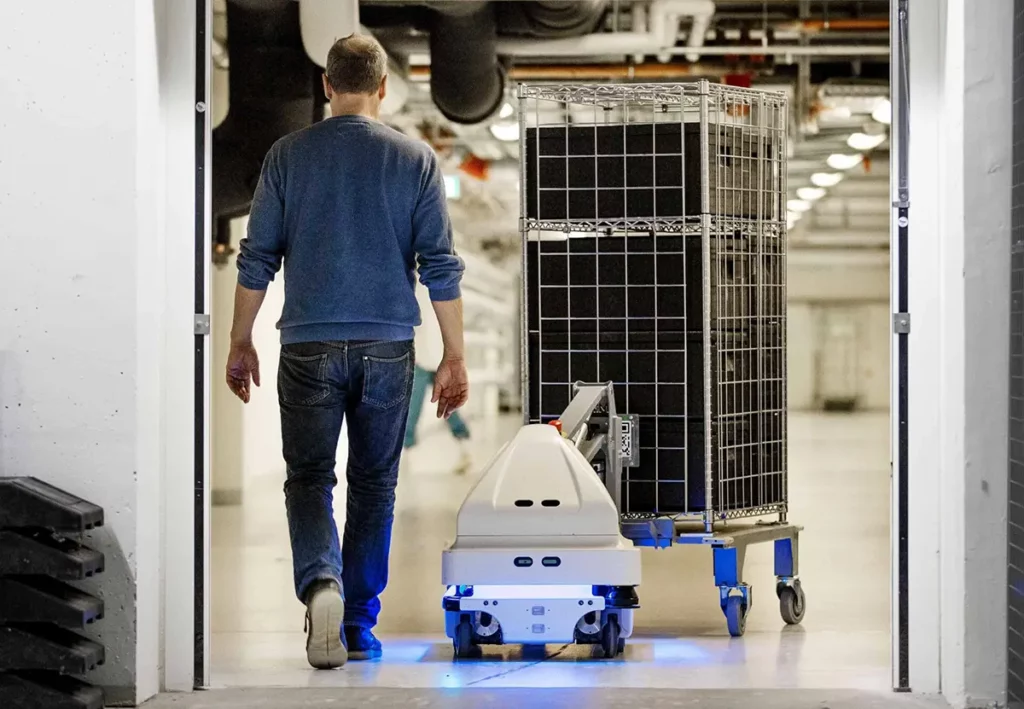The integration of robotics in the healthcare industry is rapidly gaining traction, driven by advancements in technologies like artificial intelligence (AI) and augmented reality. Robots are becoming increasingly prevalent in hospitals, nursing homes, and other healthcare institutions, serving as valuable tools in various medical applications. The recent COVID-19 pandemic has further accelerated the adoption of robotics, specifically Autonomous Mobile Robots (AMRs), in the healthcare sector. In this article, we will explore the reasons behind the increasing use of AMRs in hospitals, delve into their benefits, and discuss potential disadvantages.
Why are Mobile Robots Useful in Healthcare?
A recent study shows that about 40% of a nurse’s time is spent on non-nursing, non-value-adding tasks like delivering and retrieving meal trays or performing housekeeping duties. By automating these tasks, AMRs free up healthcare professionals’ time, allowing them to focus on critical patient care and reducing the strain of non-value-adding activities.
AMRs utilize a combination of sensors, onboard computers, AI, and SLAM technology to navigate and understand their surroundings without pre-defined reference points. Their compact size and agility make them effective in high-traffic areas and for low-volume transportation. These characteristics enable AMRs to access narrow spaces, interact with healthcare staff and patients, and provide various services, including assistive activities. Equipped with a wide array of advanced sensing technologies, AMRs can easily create maps of their environment and calculate their position. Furthermore, they can plan collision-free paths, and make real-time decisions to avoid collisions, thereby easily navigating in dynamic and unpredictable environments.
Uses of Autonomous Mobile Robots in Healthcare
AMRs offer a wide range of applications in healthcare environments, mostly used to improve workflows by moving things from one place to another. In particular, autonomous mobile robots excel and are mostly used for transportation of:
- Meals between the kitchen and the ward and empty trays back to the kitchen
- Trash bins and trolleys
- Linens
- Cleaning carts or trolleys
- Sterile supplies
- Hospital medication, laboratory tests, and other supplies
Benefits of AMRs in Healthcare
1. Enhances Workflow Efficiency
The implementation of AMRs changes every aspect of the hospitalization experience – it simplifies routine tasks, and reduces the physical demand on human workers, thereby ensuring more consistent and efficient processes. The robots can also address problems with staff shortages by keeping track of inventory and even placing orders to ensure everything is in stock where needed.
2. Safe Working Environment
By taking over physically demanding and repetitive tasks, these robots help prevent injuries and alleviate the strain on staff members. Additionally, AMRs can operate in hazardous areas, such as isolation units or environments with biohazardous materials, reducing the risk of exposure for healthcare workers.
3. Improved Patient Care
When AMRs take off some burden from the workers’ shoulders, it not only accelerates necessary processes but also enhances the psychological well-being and motivation of healthcare workers. As a result, patients benefit from a better overall experience as nursing staff have more time to provide dedicated care, while decreased patient costs are achieved by leveraging AMRs for tasks like meal and medication delivery, making healthcare facilities more competitive and cost-effective.
Disadvantages of AMRs in Healthcare
1. High Acquisition and Maintenance Costs
The initial investment and ongoing maintenance of AMRs can be substantial. Hospitals and healthcare facilities need to allocate sufficient resources to acquire, integrate, and maintain these advanced robotic systems.
2. Limited Long-Term Research
As the field of AMRs in healthcare is still relatively new, there is a lack of long-term research regarding their effects and potential limitations. It is crucial to continue monitoring and studying the impact of AMR deployment to ensure safety, efficiency, and patient satisfaction.
3. Emotional Support Limitations
AMRs, despite their advanced capabilities, cannot fully replace human interaction and emotional support. Patients may still require human presence and empathy, which robots are unable to provide. Integrating AMRs while maintaining the human touch in patient care remains a critical balance.

The utilization of AMRs in healthcare represents a significant advancement in the industry, with far-reaching benefits. These robots contribute to improved patient care, streamlined workflows, cost savings, and a safer work environment for healthcare professionals. By automating material handling and logistics, AMRs can provide peace of mind for workers and patients alike, reducing stress and increasing the level of care that facilities are able to provide.

